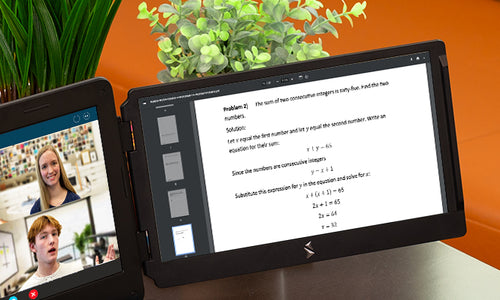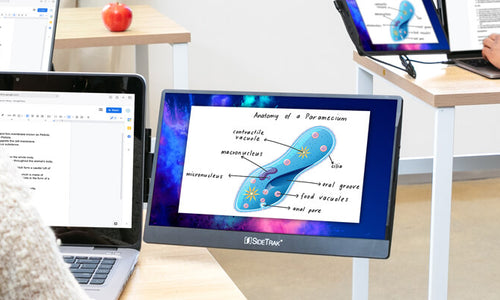Benefits of Technology in the Classroom
Nowadays, students without access to technology are at a significant disadvantage. A report from The National Science Board states that an ever-increasing number of schools are issuing laptops or other mobile devices to their students so that they can connect to the internet, access materials, and work on assignments. Using technology in classrooms can have many benefits. Here are a few of them.
Technological Readiness
As technology becomes more and more prevalent in all aspects of our lives, it’s logical to think that jobs in the future will require a technology-inclusive education. Linda Darling Hammond, the faculty director of the Stanford Center for Opportunity Policy in Education, notes that “when given access to appropriate technology used in thoughtful ways, all students—regardless of their respective backgrounds—can make substantial gains in learning and technological readiness.” Not providing today’s students with adequate digital learning tools almost guarantees they will be left behind.
The Association for Supervision and Curriculum Development confirms that expenditures on education technology will soon top $56 billion. A report conducted by Gallup, Inc. found that 81% of teachers highly value the use of instructional technology in the classroom, and 85% say they see that value increasing in the future. This same study found that 65% of teachers that already use technology in the classroom have seen the benefits in several ways.
More Enjoyable Learning Experience
It’s hard to argue that learning and retaining information is easier when the experience is enjoyable, and 96% of students say that digital learning tools make lessons more fun. Their teachers have, across the board, noticed a positive shift in focus as well. 70% of students even say having technology in the classroom helps them learn things on their own, which helps deepen their understanding of any given subject.
Now that we have these new teaching capabilities, shouldn’t we also facilitate them in a way that truly allows the students to shine? Multiple reports, including one by The New York Times, have found that adding a second screen to your set-up, like a SideTrak monitor, increases productivity by between 20-30 percent. That works out to almost 2.5 hours of each 8 hour day.
Personalized Teaching and Learning
The not-so-simple truth is that learning is a different experience for everyone, and everyone learns in different ways. A solution to this issue is to provide technology that can support instructional strategies that address the individual needs of each student.
Imagine a classroom where a lesson being taught by one teacher could be personalized for every single student there. Technology doesn’t only help teach the lesson, but it also helps students discover how they learn best. “More practically,” says the Brookings Institute, “technology has been shown to scale and sustain instructional practices that would be too resource-intensive to work in exclusively in-person learning environments, especially those with the highest needs.”
Preparation for the Future
There’s no doubt that the jobs of tomorrow will use technology. Supplying students with the most up-to-date digital learning tools will not only help them succeed now, but they’ll also arrive in the job market with a set of skills that support their career aspirations. The Brookings Institute concludes, “technology for learning when deployed to all students ensure that no student experiences a 21st Century skills and opportunity gap.” “Intentional, thoughtful inclusion of technology in public learning environments can ensure that all students, regardless of their ethnicity, socioeconomic status, language status, special education status, or other characteristics, have the opportunity to experience learning and develop skills that allow them to fully realize their potential.”
Digital learning tools turn traditionally boring subjects into engaging assignments and help teachers connect. They can enhance creativity and focus. Perhaps most importantly, they give students a more tailored learning experience that suits their specific needs. The best way to put the advantage back in the students’ hands is by providing them with the facility to succeed now and in the future.










































Personalized Teaching and Learning
The not-so-simple truth is that learning is a different experience for everyone, and everyone learns in different ways. A solution to this issue is to provide technology that can support instructional strategies that address the individual needs of each student.
Imagine a classroom where a lesson being taught by one teacher could be personalized for every single student there. Technology doesn’t only help teach the lesson, but it also helps students discover how they learn best. “More practically,” says the Brookings Institute, “technology has been shown to scale and sustain instructional practices that would be too resource-intensive to work in exclusively in-person learning environments, especially those with the highest needs.”
Preparation for the Future
There’s no doubt that the jobs of tomorrow will use technology. Supplying students with the most up-to-date digital learning tools will not only help them succeed now, but they’ll also arrive in the job market with a set of skills that support their career aspirations. The Brookings Institute concludes, “technology for learning when deployed to all students ensure that no student experiences a 21st Century skills and opportunity gap.” “Intentional, thoughtful inclusion of technology in public learning environments can ensure that all students, regardless of their ethnicity, socioeconomic status, language status, special education status, or other characteristics, have the opportunity to experience learning and develop skills that allow them to fully realize their potential.”
Digital learning tools turn traditionally boring subjects into engaging assignments and help teachers connect. They can enhance creativity and focus. Perhaps most importantly, they give students a more tailored learning experience that suits their specific needs. The best way to put the advantage back in the students’ hands is by providing them with the facility to succeed now and in the future.



